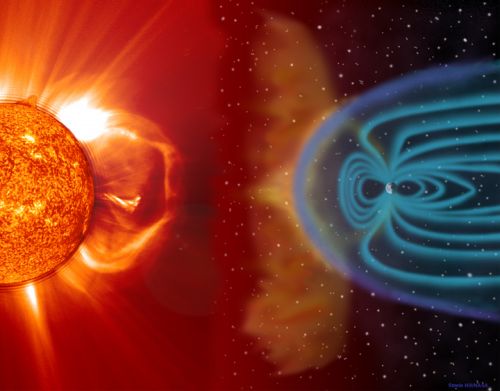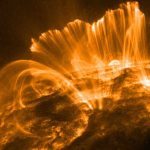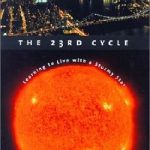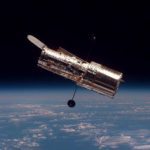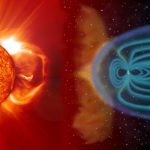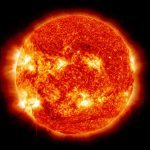“During 1999 and 2000, we really expect some wild rides. We really don’t know what effects we are going to see.”[JoAnn Joselyn, Cycle 23 Project]
The instruments on board NASA’s Solar and Heliospheric Observatory (SOHO) were routinely keeping watch on the Sun on April 7, 1997, when the EIT camera picked up a typical garden-variety, class-C6 solar flare in progress. Scientists back on earth watched while a shock wave from the flare passed through the local gases in the solar corona like the waves from a pebble dropped into a pond. It was a beautiful event to watch, looking for all the world like some artful animation, rather than the awesome detonation that it actually was. In minutes, a ring of compressed gases had spread to engulf a patch of the Sun as big as the earth. Radiation sensors onboard the geosynchronous GOES weather satellites detected a rain of flare particles minutes later. Meanwhile, radio telescopes began to detect the tell-tail radio waves from a Type II burst on the Sun. The CME, in its haste to leave the Sun, had shocked and compressed solar plasma ahead of it, snowplowing them into walls of stripped atoms and magnetic fields that emitted powerful blasts of radio waves. At 15:00 UT, as the shock wave spent itself, the LASCO instrument witnessed a major CME grow to the size of the Sun and larger.
Three days later on April 11 at 00:00 UT, the WIND and SOHO satellites, parked one million miles from the Earth towards the Sun, started to feel the direct impacts of energetic particles from the CME. The faint signals from the compressed interplanetary wind had already been sensed a few hours earlier. Ground-based magnetometer readings from CANOPUS, the Canadian magnetic observatory network, started to feel major changes in the Earth’s field heralding a Large Storm Commencement at 3:00 UT. Meanwhile, the POLAR satellite had already seen auroras begin to grow on the dayside of the Earth at 19:50 UT. By 22:26 UT, intense nighttime aurora could be seen in New Hampshire and Massachusetts as the aurora slid past the US-Canada border and plunged into the Lower-48. Many amateur photographers reveled in spectacular opportunities to capture on film both the dazzling auroral curtains, and the history-making comet Hale-Bopp.
The great series of domino events tracked by NASA satellites, literally from cradle-to-grave, prompted scientists to release a press announcement on April 8th that predicted the real meat of this CME would harmlessly pass about a few million miles below the plane of the Earth’s orbit. At best it would be a glancing blow, and most probably not a direct hit. As seen from the Sun, hitting the Earth is not exactly a turkey shoot even with a million-mile-wide bullet. The magnetosphere of the Earth extends over 100,000 miles from the center of the Earth, and has about the same apparent size as a dime held at 30 feet. Even though CMEs are huge, the Earth is such a small target, you really have to get CME and solar flares pointed right at the Earth before there’s a good chance of any physical contact happening.
The news media were especially fascinated by this cosmic salvo. The spectacular satellite images of its genesis millions of miles away, made the CME near miss almost irrelevant. It really didn’t matter if the storm would only be a glancing blow this time. April 10th turned out to be a big news day for this cosmic non-event, with nearly all of the major national and international newspapers carrying some kind of story about it. Some reporters, unfortunately, rushed into press with rather sensational stories such as Matthew Wald’s article in the New York Times, “Storm on Sun Is Viewed From Spacecraft; First detailed look at solar event that could effect life on earth”, which was datelined April 9th and published on April 10, 1997. Meanwhile, CNN and Yahoo!News, reassuringly reported in their on-line news services that “Solar Flare small after all, poses little damage” (CNN) and “Solar Storm’s Full Force to Miss Earth” (Yahoo). Even the Boston Globe reported “Not much flare to this solar event, experts say”. NBC, CBS and CNN News, carried interviews with George Withbroe, Chief of the NASA Office of Space Science, and Nicola Fox, a scientist at NASA’s Goddard Space Flight Center who coordinates the Global Geospace Science program. Nearly every news report mentioned possible technology impacts should the CME actually hit the Earth, including electrical blackouts and satellite outages.
Our Sun traces a dependable path across our skies every day, yet only very recently have we discovered that it has its share of stormy days. For the last three centuries, solar activity levels have come and gone in a roughly 11-year pulse beat that we have actually grown to expect. Even our biosphere shows the unmistakable traces of these cycles resonating in everything from carbon-14 abundances in tree rings, to global precipitation patterns and coral layering. Our eyes never see the Sun brighten or dim, nor are we even remotely aware that the Sun cycles back and forth from stormy to quiescent. It is a small cause, which manages to have a big effect on the hidden aspects of our environment. The fulcrum lies somewhere in the dark spaces between the solar photosphere and our own murky comprehension of the Sun-Earth connection.
Just knowing about the solar cycle has been a promising first step in figuring out what the Sun will do over the long haul, even though the average person on the street is hardly aware that these cycles happen. The solar cycle, however, is a poor barometer of what we should expect the Sun to do for us tomorrow, and that’s what is most interesting to satellite owners, astronauts and electrical utility managers. Within each regular cycle, the Sun is actually rather temperamental. It hurls flares and billion-ton clouds at us almost at random, dissipating with each blast, any sense of predictability.
By the time you read this chapter, one thing is certain: you will be near the end of this book, but only about half way through the current sunspot cycle – Cycle 23. If you were a solar physicist, a satellite owner, or a General in the Armed Forces, the question that you would be asking by now is, “Just how bad will this cycle be?” The answer depends on what you are concerned about. If you are worried about your communications or espionage satellite, “Will a flare erupt in the next day or so, and cause a satellite anomaly?” If you are trying to plan for next-years budget, “Are we in for a bad solar ‘summer’ with many more opportunities for weekly flares and technological difficulties?” Either way, it is hard to know with any certainty. If a flare as bad as the Cycle 20, Apollo 17 near miss arrives during ISS construction, astronauts could be seriously affected. We could also be treated to a Quebec-style blackout like we were in Cycle 22, which could cost several billion dollars to recover from. So we do what has become a reflex reaction to uncertainty in the second half of the 20th century:
We set up a committee to study the problem.
For much of this century, groups of scientists have gathered together to try to guess how bad the next cycle is going to be. With so many expensive undertakings on the agenda for this cycle, NASA and NOAA continued this long tradition in 1996 by setting up the Solar Cycle 23 Project. The first thing this panel did was to contact the rest of the astronomical community and invite everyone to send in what they thought Cycle 23 might be like. The catch was that they also had to describe in detail, what method they used to make the prediction. There was no reason for the panel to try to re-invent the wheel in solar activity forecasting, when the community they represented had already worked this particular problem for decades. The panel’s request brought to their table no fewer than 28 separate methods; by some estimates, nearly as many methods as there are researchers in this particular field. Only a few of the methods, by the way, had anything to do with the popular image of counting sunspots. Some of them tracked the rise and fall of geomagnetic storms here on Earth, others followed the total amount of radio power from the Sun at a wavelength of 10.6 centimeters. Ultimately, like an ancient traveler in Italy, all roads lead to Rome.
The biggest problem everyone had to face was that, by all accounts, the Sun was smack in the middle of the activity minimum between Cycles 22 and 23. Getting a reliable prediction for Cycle 23, without even a year’s worth of data on the new cycle, wasn’t going to be easy at all. Scientists are not at all new to this kind of a situation. They usually have to face frustration, and uncertainty, every day as they conduct their research. When you work with limited information, a common circumstance in space research, you often have to bridge the gaps by using past experience, and the collective knowledge of physical science, as a guide.
So the panel weighed the uncertainties in each of the 28 methods, and how well they had anticipated previous cycles. In the end, they were prepared to say that the time of the maximum for Cycle 23 would be around March 2000. They also hedged their bet by offering the alternative prospect that solar maximum could happen as late as June 2001, or even as early as the summer of 1999. The March 2000 prediction, however, was close to the average made by most of the methods, so that’s the one the panel favored. The panel also predicted how high the activity levels would rise, which is considerably more difficult to anticipate. Their prognosis was that Cycle 23 probably wouldn’t be as bad as Cycle 19, but it might be at least as bad as Cycle 21 with its roughly 150 spots near maximum. Incidentally, the panel didn’t consider the possibility that this ‘millennial’ sunspot cycle might be the Sun’s last one. This is not such a far-fetched possibility at all. Before 1700, telescopic observers of the Sun detected few sunspots. Their meticulous observations provided no hint to later generations of astronomers of any periodic rises and falls. There was a chance that we could wake up in 1997 or 1998 with no new cycle anywhere in sight.
Once the new cycle began, the panel’s predictions for the minimum, average, and maximum Cycle 23 activity curves soon had data starting to crawl up as though the Sun were navigating a three-lane highway. It was pretty obvious by December 1999 that the predicted trends were running a bit higher than expected. Monthly sunspot averages were just below the curve the Panel had proffered as their minimum activity prediction. Rather than the high-speed lane, the Sun slowed to the breakdown lane to get through the turn of the Millennium.
So far, the ascent up the jagged curve of Cycle 23 has been quite a wild ride. The years 1997 and 1998 had their share of spectacular solar eruptions and auroral displays. On the other hand, 1999 was uneventful for the Earth despite the fact that over 100 CMEs were being ejected by the Sun each month.. The good news was that Cycle 23 was not going to be a major storm period this time; at least not like the levels reached in Cycles 21 and 22. When you factor-in the details of individual flares and CMEs, the dossier for Cycle 23 has turned out to be dramatically more complicated than what a simple count of sunspots would tell you. It is the day-to-day engagements with solar flare and CME ‘bullets’ that can cause harm.
As scientists settled in to watch their data eagerly anticipating new breakthroughs in solar research, the news media also developed an interest in keeping watch on the Sun. In fact, Cycle 23 has been hawkishly watched in a way that no other previous cycles have been. Armed with the latest spectacular imagery from NASA’s satellites, it has been much easier to anticipate when bad things might be brewing, because you can actually see them happen days in advance. Even school children can visit NASA web sites to view images of today’s solar surface and make their own predictions. Before the first spots of this cycle started to appear, Time magazine announced in 1996 that, “Cosmic Storms Coming”. A year later, Space News also cautioned their readers that “U.S. Scientists Warn of Rise in Solar Flares”. NASA held a formal press conference at the Jet Propulsion Laboratory on February 15, 1996 which was heralded as a ‘Briefing Directly Linking Solar Storms to Disruptions on Earth”. The briefing topic was about 70 years too late given all of the impacts we had already endured during the 20th Century.
Cycle 23 officially began in September, 1996 when the first spots of the new polarity cycle were spotted, followed by a month when not a single new spot was seen. As the first spots of this cycle began to slowly appear at high solar latitudes. Like solders nervously sitting in a foxhole waiting for the first rounds to fly, engineers and scientists braced themselves for the inevitable solar onslaught. They didn’t have long to wait. Barely three months after the start of the new cycle, the first major solar event leaped out at the Earth and, by many accounts, claimed its first technological casualty: one of the key satellites of our communication infrastructure – Telstar 401.
This was followed by the April 10th near-miss of the Earth by another CME which was highly publicized. NASA scientists, armed with their new satellite technology, were now ‘two-for-two’ in having predicted the course of major solar storm events during the new sunspot cycle.
A month after the April 10th near-miss, Space News, a much-read weekly newspaper of the space community, carried a short article about a major new-generation satellite, which had encountered space weather difficulties at about the time this solar event reached Earth’s orbit. The Tempo-2 satellite, equipped with the latest in high-power, gallium-arsenide solar arrays lost 15% of its operating power on April 11, and this was directly credited to the solar storm by Loral’s Space Systems Division who manufactured the satellite. In a May 1 statement from company spokesperson David Benton announced that,
“We have evidence from sensors on the satellites that there was a space event in the vicinity of the Tempo satellite at the time of the disturbance.”
The Space News article also mentioned that a spokesman for the satellite owner, TCI Satellite Entertainment, took a far more cautious position for why the satellite lost some of its operating power. Unlike Loral who credited the space weather event with the problem, TCI announced that they were “unclear whether the storm had actually exceeded the levels the satellite was built to withstand, or if the satellite simply had a flaw”. Compared to the murky causes surrounding the Telstar 401 outage, this level of candor by Loral was refreshingly to the point, even though the satellite owner preferred a more guarded opinion. It would, of course, be the satellite owner that would seek insurance payments, not the satellite manufacturer. In a replay of the Telstar 401 settlement, TCI filed a claim for $20 million.
Far from being just another satellite stamped from a tried-and-true design, Tempo-2 was supposed to be the vanguard of a whole new fleet of high-capacity communications satellites. Communication satellites had evolved from humble 10-watt ‘small reptiles’ to leviathan multi-kilowatt ‘dinosaurs’ driven by the relentless evolutionary pressure of consumer demand. To generate the 10s of kilowatts of power needed to operate dozens of transponders and other high-end equipment, engineers had been forced to create lighter-weight, and higher-power solar cells. The current darling for this new technology is based on semiconductor compounds of gallium and germanium, rather than the common silicon cell materials. The new cells would be wired to produce 60 volts per module to keep the weight and size of the solar panels within the limits set by the cost of the satellite. One of these panels, incidentally, could comfortably supply the needs of a medium-sized house. But the Tempo-2 failure uncovered a potentially fatal problem with these new panels. They were susceptible to energetic particle impacts, which caused miniature lightning bolts to flare-up and short circuit sections of the panels. Engineers would certainly have to go back to the drawing board to fix this problem, because these satellites were to be the wave of the future.
Compared to winter and spring, the rest of the summer of 1997 unfolded in comparative calm. Although there is no public data on anomalies experienced by commercial or military satellites at this time, deteriorating space weather conditions by the end of September were openly cited as the cause of a Japanese satellite glitch. On September 20, 1997, the $474 million Adeos research satellite, launched by Japan a year earlier, began to malfunction. According to a report in Space News,
“…Cosmic rays were found to have damaged the main on-board computer, which caused it to shut down all non-essential systems, including the sensors, forcing scientists to reprogram its software”
There were no obvious geomagnetic storms in progress near the Earth on this particular day according to the Canadian CANOPUS magnetic observatory network, so whatever space event had taken its toll on Adeos, it had managed to skirt the sparse network of instruments available to record it. When you have one trillion cubic miles to cover, there are plenty of opportunities for a handful of instruments to be in the wrong place to see anything. In many ways, it’s like trying to keep track of the weather in Tokyo from monitoring stations in Stockholm, Manila and Rio de Janero.
Close on the heals of the Adeos satellite problem, the Sun decided to get back into the act of terrorizing the Earth. The SOHO satellite witnessed two major CME events on September 24 and September 27. The events were echoed in the data returned by the ACE satellite on September 30th as the CME plasma rushed by the satellite at nearly one million miles per hour. CNN News and the Reuters News Service reported that India had lost an advanced communications satellite, INSAT-2D on October 2, 1997 because of a power failure. The satellite, launched June 4, 1997, carried 24 transponders for relaying Indian telephone and television traffic. The satellite’s problems seem to have started on, or before, October 1 when it lost Earth-lock briefly, shortly after the September 27th CME had passed the Earth on September 30th. One of its predecessors, INDSAT-1C launched on July 21, 1988, fell silent under similar circumstances in 1989. According to a summary for INSAT-1C in Janes Space Directory “..a power system failure from a solar array isolation diode short” caused the satellite to lose half of its capacity. On November 22, 1989 the satellite lost its Earth lock and was abandoned at a cost of $70 million.
For INSAT-2D, ACE magnetometer data showed a sharp rise in solar wind strength on October 1 at 0000 UT followed by a persistent plateau of magnetic field intensity lasting a full day before subsiding again. The Earth-orbiting GEOTAIL satellite also noted a sharp change in the local energetic particle conditions as well as geomagnetic field strength. All of these are consistent with the arrival of the September 27 CME around October 1 at the time the INSAT-2D began having its problems.
The Insat-1C, by the way, failed on November 22, 1989 during the last of a series of major solar and geomagnetic storm events of this memorable year. These storms caused major increases in energetic protons at energies above 10 MeV, between October 19 through November 6, rivaling all of the events in solar cycle 22 taken together. On November 15th another powerful solar blast was detected on ground-level neutron monitors, and at the end of November another major solar flare, rich in high-energy protons, was recorded. According to space researcher Joe Allen at the NOAA National Geophysical Data Center, each of these events caused power panel degradation in a variety of satellites. Some lost 5-7 years of usable lifetime. Others suffered a variety of glitches and operational anomalies.
Thanksgiving, Christmas, and New Years passed uneventfully, at least by any outward appearance here on Earth. Meanwhile, 93 million miles away, the Sun continued to steadily ratchet-up its tempo of delivering CMEs to nearly 50 per month. On April 15, 1998 one of these events produced some unsettled geomagnetic conditions here at the Earth. A few days later on April 20 at 10:21 UT, the strongest solar proton flare recorded since 1994 made a stellar appearance. It was an M1-class eruption; among the literally hand-full of severe flares the Sun likes to cook-up each cycle. In keeping with the unpredictable nature of these disturbances, even though the solar storm involved both a CME and a powerful solar flare, geomagnetic conditions here at the Earth were barely affected. A week later, a second round of storms commenced with a major outpouring of pyrotechnic events. This was, however, just a warm-up pitch for what would turn out to be one the largest storms in 1998.
A series of low-level, X-class flares and multiple CMEs were expelled between April 29 and May 2. The outfall finally started to reach the Earth around May 2-3 causing a severe geomagnetic storm. Only three times before, during the January 1997, April 1997 and November 1997 encounters, had scientists gone so far as to provide formal press briefings for impending calamities. Like earthquake forecasting, it is better to miss a few quietly, than announce false positives. But the conditions, this time, seemed to warrant some kind of official comment just in case the storms might grow to become something more provocative than the topic of a scientific research paper. So far, the scientists seemed to be batting 100. The last three press releases had confirmed that scientists could anticipate the likely geospace impact of some solar storms. This new one would extend this winning streak to four.
On May 4 at 00:18 EDT a strong GIC affected the northeast United States as capacitor banks were tripped. This caused transformer saturation affecting a major electrical substation in New Brunswick, and caused voltage regulation problems throughout Maine. Minutes later in New York state, voltages also started to drop in the eastern part of the state. The Nova Scotia electrical company measured 70 ampere GICs in one of its transformers. A day later, routine testing of a transformer in the Hudson Valley indicated insulation damage and a temperature spike of several hundred degrees Celsius. According to John Kappenman at MetaTech Corporation, the Hudson Valley electrical utility recorded this problem as due to ‘undetermined causes’.
Satellite owners had also experienced their own spate of problems, many of them fatal, between April and July of 1998. Apparently the first satellite to succumb to these conditions, and publicly acknowledged, was the German research satellite Equator-S. On May 1 the satellite owned by the Max Planck Institute lost its backup processor. According to an announcement by the Institute at the official web site for this satellite,
“If a latch-up caused by penetrating particle radiation was the cause, there is hope that it may heal itself upon the next eclipse because of the complete temporary switch-off of the electrical system”
After no mention of any satellite problems among the 70+ satellites now in orbit since their first launch on May 5, 1997, Space News reported four Iridium satellites launched prior to May 1 had already failed. By May 8 this number jumped to five, and by July 23 there were now seven Iridium satellites that had failed or were ailing. One of the failures apparently had something to do with a satellite separation problem during a Delta 2 launch. The Iridium satellite network has been built with the assumption that about six satellites per year will have to be replaced. 1998 easily reached that mark. Although there is no hard evidence to suggest the rest of the Iridium satellites failed because of the major space weather events of April-May, the timing of the press releases seems more than coincidental. So many in-orbit failures for a satellite system barely a year old, led to a predictable loss of confidence from stockholders. Investors voted with their feet by dropping the stock price for Iridium LLC $10 to 46 3/4 a share. Motorola’s spokesman Robert Edwards noted, optimistically, in a Space News article that Motorola does not believe there is a common link behind the seven failures so far, although two of the satellites had their functions restored and are now working normally. According to International Space Industry Report, an unnamed ‘industry sources’ confided that, “These are no doubt reaction wheel failures; at least seven wheels have mission-threatening problems or failures”. Meanwhile, another ‘Big LEO’ satellite program, Teledesic, was having its own problems before it even got a chance to put any of its 288 satellites in orbit. On May 7, the Teledesic 1 (T1) experimental satellite was no longer operating as planned. No details were given either of the cause of the malfunction, the systems involved, or the time when the satellite failed.
The most spectacular outage since Telstar 401 rocked the satellite community on May 19th when the $165 million, Galaxy IV satellite suddenly went for an unplanned stroll and mispointed its antenna. By some accounts, as many as 45 million pagers in North America instantly went silent. This outage was followed on June 13th by the loss of the primary control processor on the Galaxy VII, and an identical problem with the DBS-1 satellite on July 4. PanAmSat Corporation, the owner of the three Hughes model HS-601 satellites, was never able to identify a clear cause for these failures. International Space Industry Report carried a headline “Hughes Hit Hard by Satellite Failures”.
‘The failures have sent Hughes scrambling for an explanation, and left industry analysts wondering whether other Hughes-built satellites of the same family may be subject to similar problems”
Space physicist Dan Baker and his colleagues at the University of Colorado, however, uncovered satellite evidence for a very disruptive space environment spawned by the April-May solar activity episode. There was a major NASA, POLAR satellite anomaly on May 6, and more than a dozen anomalies plagued Japan’s Global Meterological Satellite system between May 4-7. What was interesting about the data presented by Dan Baker, was that it showed how active the geospace environment could remain even several weeks after a major CME impact. Could the outage of the Japanese ETS-7 satellite 2-3 weeks after the November 7, 1997 storm fall into the same category of delayed satellite impacts? The March 22, 1991 flare was so powerful, and rich in energetic particles, that it actually caused a new radiation belt to form around the Earth. The Combined Release and Radiation Effects Satellite (CRRES), Geostationary Operational Environmental Satellite (GOES-6) and the Geostationary Meteorological Satellite (GMS-4) had no problems detecting this belt. The belt was even seen by dosimeters on board the STS-40, STS-42 Space Shuttle missions, and MIR space station up to 10 months later. There were no space weather events at the time of the Galaxy VII outage, but ACE and WIND sensors detected a very strong disturbance in the solar wind between July 1-3. The more scientists study the response of the geospace environment, the more they seem to discover it is a morass of delayed effects and complex phenomena that don’t always deliver their worst punches after an obvious, well-telegraphed, encounter with the Sun.
As summer declined into the Labor Day hiatus, on August 27 1998 a severe geomagnetic storm, and yet another press release, was triggered by the arrival of a CME event aimed directly at us. At 3:00 EST on August 26, plasma from the CME finally arrived at the Earth and began to trigger a major geomagnetic response, recorded by the 13 magnetic observatories operated by the USGS as far south as Hawaii. The US Geological Service, which seldom wades into the Space Weather arena in such a public manner, thought enough of this event to issue its own press release “USGS Reports Geomagnetic Storm in Progress”. Spectacular aurora, meanwhile, were observed as far south as North Dakota. Sometime during, or before, the week of September 9, another Iridium satellite suffered a malfunction.
September 23 saw yet another CME provide a replay of the severe ‘Labor Day Storm’. Again, dazzling green and red aurora reaching as high as 1/2 way up the northern horizon corusced in North Dakota and Canada. A major M2-class proton flare added to this chorus a week later on September 30.
The rest of 1998 passed uneventfully with the Sun continuing to produce between 40-60 CMEs per month. The SOHO satellite, which had experienced a commanding problem on June 24, had by now recovered all of its scientific functions, and its handlers were learning how to operate it with out the benefit of its gyros. Other satellite handlers were not having such a happy conclusion to their labors, though. On December 20, 1998 the NEAR spacecraft was just beginning a crucial 20-minute burn of its thruster to ease it gently into orbit around the asteroid Eros. The thrusters were turned on by the satellite following a pre-recorded set of instructions, but suddenly the spacecraft aborted its firing. For 27 hours, the satellite refused to speak to Earth until ground controllers finally got a weak reply from it. They quickly uploaded commands for NEAR to take as many pictures as it could as it hurled past Eros. Why had the carefully planned rocket firing gone awry in mid-execution? By June 1999 engineers had run numerous tests using identical computers and software, but were unable to reproduce the glitch. A similar thruster firing had to be commanded exactly on January 3, 1999 so that NEAR could return for a second orbit insertion try in February 14, 2000. This time there was no glitch.
Not all mysterious problems in space necessarily have a space weather explanation as their root cause. Sometimes it really can be a finicky line of computer code or an outright hardware failure. These explanations usually become obvious after investigators carefully sift through the satellite’s housekeeping data which, like an airliner’s ‘black box’ describe what the satellite was doing prior to the mishap. Neither of these explanations seemed to apply to the NEAR spacecraft since its second thruster firing went-off without a hitch. But many problems can have something to do with local environmental factors, especially when we voyage into interplanetary space and confront the unknown. On September 29, 1989 a category X-9.8 solar flare was recorded on the backside of the Sun, and not visible from the Earth. The Magellan spacecraft enroute to Venus experienced power panel and star tracker upsets from the portion of the solar flare that had passed its way. ACE satellite observations of the solar wind show that it was far from calm around the time of the NEAR mishap. Even so, the specific environment in the vicinity of NEAR cannot be estimated from only ACE satellite data measured at one point in a different part of the solar system.
There were five significant solar proton flares recorded in January, April and June 1999, but none strong enough to warrant much alarm near Earth orbit. The only significant satellite event to happen during the first half of 1999 occurred on March 12 when GE Americom’s GE-3 satellite suffered an anomaly affecting its station-keeping ability, causing the satellite to spin out of control. The satellite had been placed into service September 1997 and its transponders carried a number of feeds for CNN, PBS and Turner Classic Movies. Readings from the ACE and WIND satellites at the time showed that between March 10-13th, there was a space weather event in the solar wind. Particle densities and magnetic field strengths increased 5-20 times above typical baseline levels before and after this event. There were no geomagnetic storms in progress on this date, however.
Once again, India’s satellite weather service was brought low by the failure of another of their satellites, this time Insat-2E. In a Space News report on November 29, mention was made that this satellite had started to have problems ‘about two months ago’. Despite simulation studies which showed that the undisclosed problem might be rectified, they finally went public with the problem and announced that the satellite was being taken out of service. Geomagnetic indicators provided by the CANOPUS and SESAME magnetometer networks in Canada and Antarctica showed that mild storm conditions existed around September 23 and 27, and ACE satellite data also showed two large space weather events at this same time.
The only really severe geomagnetic event in 1999 occurred on October 22 when conditions were elevated to a Large Storm status for a single day; the first time since November 1998. There were no published satellite outages, but John Kappenman, an electrical engineer with MetaTech Corporation, notes that some North American power utilities recorded transformer trips on October 23 that could have been related to this storm.
As you can see from the chronological listing of satellite outages and anomalies the Table 5 during the first half of Cycle 23, this cycle has been far from inconsequential. The published satellite outages, totaling nearly $1 billion so far this cycle, tend to happen close-by some significant space weather event. The worst of these to date has been the April-May 1998 storm whose lasting effects seem to have left in its wake a number of satellite outages and severe operational anomalies. What is also interesting from this record is that, with over 2000+ communications and military satellites in orbit and operational, the actual, severe, satellite anomaly count from these storms is so small. We cannot know if this is simply the result of selective reporting, but at least for the military satellites, it is obvious that military secrecy is a powerful inhibitor to announcing these satellite outages. The list of commercial satellite outages and mission-threatening anomalies in Table 5 is probably complete, since it is difficult for major communication satellite lapses to be hidden from the news media when they happen. This suggests that, in fact, the vast majority of the present commercial satellites are surprisingly robust in operation through even the most adverse space weather conditions we have seen since Cycle 23 began. There are, however, some very obvious and troubling tendencies that have grown more apparent in these commercial satellite reports.
Rarely do commercial satellite owners give specific dates and times for the outages, and in the case of Iridium, the specific satellite designations are even suppressed, as is any public discussion about the causes of the outages themselves. If this is to be the wave of the future in commercial satellite reportage, especially from the Big LEO networks now being planned such as Teledesic, we are in for a protracted period of confusion about causes and effects. Without specific dates and reasons for failure, scientists cannot then work through the research data and identify plausible space weather effects. This also means that the open investigation of why satellites fail, which could lead to improvements in satellite design, and improved consumer satisfaction with satellite services, is all but ended. As Robert Sheldon notes,
“…the official AT&T failure report [about the Telstar 401] as presented by Dr. Lou Lanzerotti at the Spring AGU Meeting denied all space weather influence and instead listed three possible [technological] mechanisms…This denial of space weather influence at this meeting was met with a murmuring wave of disbelief from the audience who no doubt had vested interests in space weather”.
Moreover, a new factor has begun to enter the equation. For years, NOAA had kept a master file of reported satellite anomalies from commercial and military sources. The collection included well over 9000 incidents reported to NOAA’s Space Environment Center during previous decades. This voluntary flow of information dried-up in 1998 as one customer after another stopped providing these reports. From now on, access to information about satellite problems during Cycle 23 would be nearly impossible to obtain for scientific research. More than ever, examples of satellite problems would have to come from the occasional reports in the open trade literature, and these would only cover the most severe, and infrequent, major satellite failures. There would be no easy record of the far more numerous daily and weekly mishaps, which had been the pattern implied by the frequency of these anomalies in the past.
So far, Cycle 23 has brought with it a mixed bag of problems; the only thing missing is a power blackout. No one really wants to benefit from the chaos that results from a severe blackout. Still, NASA space scientists, and NOAA Space Weather Forecasters, would be silently grateful for a new ‘event’ that would keep space weather forecasting in the public and congressional eye. Even engineers for the electrical power industry bemoan the lack of any significant storms during the first half of this cycle to trigger a Quebec-style blackout. Without a large, socially-significant, event it is unlikely that electrical utility company managers will be interested in Space Weather Forecasting and the latest GIC prediction systems. For the few thousand dollars this would cost per month for an electrical utility, to many electrical power managers, this just doesn’t seem to be worth the cost. Many of them worry about the more obvious sources of traditional power outages such as ice storms, tornadoes and downed tree-limbs. The lack of a compelling event hasn’t been because the Sun has, somehow, kept a low profile.
Between June and September 1999 alone, 100 CMEs per month blasted out from the Sun into the dark interplanetary depths, fully three times the rate that the current solar cycle had started with back in 1996. The minor blips that the lucky few squalls delivered to our shores did little more than cause a steady drumbeat of geomagnetic storminess, and a few good aurora: Great for amateur photographers; Bad for low-visibility space weather forecasting. We still have another 3-4 years to go before solar minimum conditions are reinstated. If the first half of this cycle has been an expensive one for satellite insurers, the second half may still harbor some surprises for us too.
As Cycle 23 pushes beyond its peak and begins its descent during the next few years, we still have to consider it a cycle to watch carefully. It will, after all, be during the declining years of the cycle that much of the planned space real estate will be in place and serving our needs. Some of the most medically and technologically-troubling storms have a penchant for happening during the years immediately following sunspot maximum. Astronauts will be assembling the International Space Station and inhabiting it in, what many hope, will be ‘routine’ shifts. Everyone is counting heavily that space station crews will not have to be rushed back to Earth to avoid being radiation poisoned. Shuttle Missions continue to play a cat-and-mouse game with the LEO environment, but the two days of accumulated spacewalks between 1996-2000 have not provided much of a target for the Sun’s storms. Since Cycle 23 began, and by the end of December 1999, satellite and ground-based instruments have steadily ticked off about 80 significant geomagnetic storms, 15 solar proton flares and an unbelievable 2000+ CMEs. Ultimately, we have to remind ourselves that the game we are playing is not one of Chess, where pieces always move logically and in recognizable patterns. Instead, the game is largely one of chance. There are, however, many ways that we can improve the odds that our technology will survive unscathed. One of these is simply to become much more adept in anticipating when solar storm conditions will occur, and what their specific impacts will be here at the Earth when they arrive.
More From SolarStorms.org:
Submit your review | |

